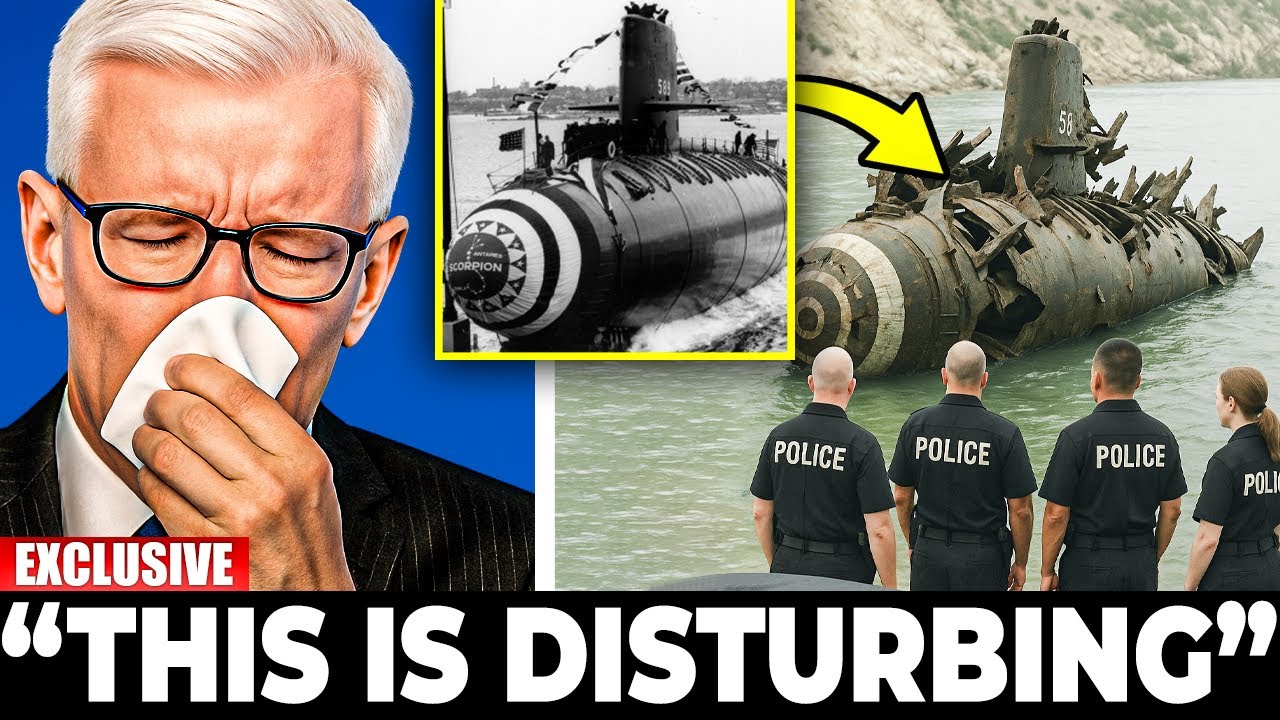What really sank the USS Scorpion, taking 99 lives into the Atlantic’s abyss? 😱⚓
In 1968, a U.S. nuclear submarine vanished without a trace, sparking decades of mystery and conspiracy. Now, experts have uncovered chilling new evidence that points to a shocking truth—mechanical failure, a deadly explosion, or something far darker? The answers will leave you reeling.
Want to know what they found? Dive into the haunting details here:

On May 22, 1968, the USS Scorpion (SSN-589), a Skipjack-class nuclear-powered attack submarine, vanished in the Atlantic Ocean, 400 miles southwest of the Azores, carrying 99 crew members and two nuclear torpedoes. Declared missing on May 27 when it failed to return to Norfolk, Virginia, the submarine’s fate remained one of the U.S. Navy’s greatest enigmas for decades, fueling theories of mechanical failure, torpedo malfunction, and even Soviet attack. In recent years, declassified documents, acoustic analyses, and new investigations have shed light on the Scorpion’s final moments, pointing to a devastating chain of events that culminated in its implosion at 11,000 feet. While the exact cause remains debated, the evidence suggests a tragic interplay of technical flaws and operational pressures, with no definitive proof of foul play. This article explores the latest findings, the Scorpion’s mission, and the enduring lessons from one of the Cold War’s darkest maritime tragedies.
The USS Scorpion: A Cold War Workhorse
Commissioned on July 29, 1960, the USS Scorpion was a pinnacle of Cold War naval engineering, designed to counter Soviet submarine threats. At 251 feet long, with a teardrop-shaped hull and a Westinghouse S5W nuclear reactor generating 11,000 kilowatts, it could reach speeds of 33 knots underwater, making it one-third faster than earlier nuclear submarines like the Skate class. Armed with six 21-inch torpedo tubes and carrying a mix of Mark 37 and Mark 45 nuclear torpedoes, the Scorpion was a formidable asset, tasked with surveillance and anti-submarine warfare.
In February 1968, under Commander Francis Slattery, the Scorpion embarked on a three-month Mediterranean deployment with the Sixth Fleet, including a last-minute mission to spy on Soviet warships near the Canary Islands. However, the submarine’s maintenance history raised concerns. A planned 1967 overhaul was reduced to a $3.2 million “Reduced Availability” repair, far below the standard $20 million, with much of the work done by the crew. This cost-cutting, driven by Cold War demands, left unresolved issues, including hydraulic leaks and substandard brazed joints, mirroring flaws exposed in the USS Thresher’s 1963 loss.
The Final Voyage: A Descent into Darkness
On May 21, 1968, the Scorpion sent its last message from 250 miles southwest of the Azores, reporting it was homeward bound for Norfolk, expected to arrive on May 27. When it failed to appear, the Navy declared it “overdue and presumed missing” on June 5, initiating a massive search involving 55 ships and 23 aircraft. Acoustic data from the Navy’s Sound Surveillance System (SOSUS) and a Canary Islands hydrophone station detected 19 hydro-acoustic signals lasting 91 seconds on May 22 at 18:42 GMT, consistent with the submarine’s hull imploding at crush depth. By October 28, 1968, the USNS Mizar located the wreckage at 11,000 feet, revealing a shattered bow, a displaced sail, and a trench from the hull’s impact with the sea floor.
The Navy’s 1968 Court of Inquiry, led by Vice Admiral Bernard L. Austin, concluded that “the certain cause of the loss of the Scorpion cannot be ascertained from evidence now available.” However, declassified documents in 1993 and subsequent analyses, including a 2012 study by retired acoustics expert Bruce Rule, have narrowed the likely causes. The leading theory points to a hydrogen explosion caused by battery cell issues, exacerbated by changes in ventilation during a maneuver to periscope depth. Dave Oliver, a retired rear admiral, supports this in his book Against the Tide, citing hydrogen buildup as the probable trigger.
The Hydrogen Explosion Hypothesis
The Scorpion’s battery, critical for auxiliary power, was prone to hydrogen gas buildup during charging, a known risk in submarines. Historical incidents, like the USS Cochino’s loss in 1949, underscored this danger. Rule’s analysis of acoustic data suggests a hydrogen explosion occurred at a shallow depth (250 feet or less), initiating flooding in the operations compartment or torpedo room, followed by the hull’s implosion at 2,000–2,400 feet. The Naval Ordnance Laboratory (NOL), in a year-long study, ruled out a large external explosion, such as a Soviet torpedo, noting the acoustic events lacked the signature of such an attack.
An alternative theory, proposed by Dr. John P. Craven, suggests a “hot-running” Mark 37 torpedo, activated inadvertently in its tube, caused an internal explosion. Concerns about the Mark 37’s silver-zinc battery, with a thin foil barrier prone to breaking under vibration, supported this hypothesis, as a similar incident occurred on the USS Sargo in 1960. However, the NOL study found no evidence of multiple torpedo detonations, which would have obliterated the submarine, as the Scorpion carried 23 torpedoes with 7,770 pounds of explosives. The wreckage’s relatively intact state, with a bowed bulkhead but no catastrophic fragmentation, weakens the torpedo theory.
The Soviet Attack Theory: A Cold War Conspiracy?
Some, like author Ed Offley in Scorpion Down: Sunk by the Soviets, Buried by the Pentagon, argue the Scorpion was sunk by a Soviet submarine in retaliation for the alleged U.S. sinking of the Soviet K-129 in March 1968. A 2018 report cited radioman Mike Hannon’s claim of detecting a Soviet submarine leaving the area at high speed on May 23. However, no physical or intelligence evidence supports this, and the NOL’s acoustic analysis contradicts an external attack. The Scorpion’s diverted mission to monitor Soviet ships near the Canary Islands heightened tensions, but experts like George Behe dismiss Soviet involvement, citing the lack of debris consistent with a torpedo strike.
The Search and Discovery
The search for the Scorpion was a technological feat led by Dr. John P. Craven and the USNS Mizar, which had previously located the USS Thresher. Using SOSUS data and a 12-by-12-mile search grid, the team pinpointed the wreckage by October 1968, with photographs showing the bow skidded into the sea floor and the sail dislodged. The Trieste II submersible’s 1969 dives confirmed no radiological leaks from the nuclear reactor or torpedoes, which remain monitored.
Human and Cultural Impact
The loss devastated families, like that of ETN2 Richard G. Schaffer, honored at the Arkansas Inland Maritime Museum. Two crew members, Joseph Underwood and Bill Elrod, survived by transferring off the submarine days before, later testifying to minor hydraulic issues but overall operational stability. The tragedy, coupled with the Thresher’s loss, spurred the SUBSAFE program, enhancing submarine safety.
Culturally, the Scorpion’s mystery fueled books and documentaries, with conspiracy theories persisting despite evidence. The U.S. Submarine Veterans’ 2012 call for a new investigation was denied, reflecting the Navy’s stance that the hydrogen explosion theory is most plausible.
Lessons and Legacy
The Scorpion’s loss exposed the risks of rushed maintenance and Cold War pressures. The reduced overhaul, akin to the Thresher’s shortcomings, highlighted the need for rigorous quality control. The SUBSAFE program, implemented post-Thresher, was strengthened, preventing similar disasters in later incidents. The Scorpion’s nuclear payload, still resting at 11,000 feet, underscores the environmental stakes of deep-sea wrecks, with periodic Navy monitoring ensuring no contamination.
Conclusion
The USS Scorpion’s sinking, likely caused by a hydrogen explosion from battery issues, reflects a tragic convergence of technical flaws and operational demands. While conspiracy theories of Soviet attacks persist, recent evidence leans heavily toward an internal failure, confirmed by acoustic data and wreckage analysis. The Scorpion’s story, like the Thresher’s, serves as a sobering reminder of the perils of undersea warfare and the human cost of cutting corners. Its legacy endures in safer naval practices and the unresolved grief of 99 families, forever tied to the Atlantic’s depths.





